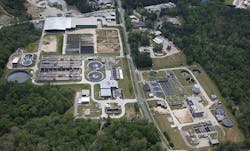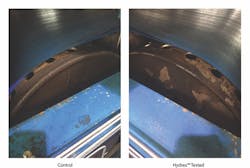Mitigating Struvite at North Durham Water Reclamation Facility
The Client
The City of Durham is located in the Research Triangle Region of North Carolina. The City operates two wastewater treatment plants – the North Durham Water Reclamation Facility and the South Durham Water Reclamation Facility, both permitted to treat 20 million gallons per day (MGD).
The Client’s Needs
The North Durham Water Reclamation Facility operates two Ashbrook Belt Filter presses five days a week to process their sludge. The incoming sludge has magnesium, ammonium, and phosphorus that form struvite deposits that accumulates on the hard surfaces of the belt filter press. The accumulation of struvite causes the rollers and other areas of the belt filter press to build up these deposits overtime. This build up limits the efficiency of the equipment and causes additional issues with maintenance and repair.
The Solution
The North Durham Water Reclamation Facility allowed Veolia Water Technologies to provide an extended pilot test dosing Hydrex™ 67809 to mitigate struvite accumulation from their belt filter presses. Hydrex™ 67809 is a non-corrosive, non-hazardous chemical formulation that inhibits and retards the onset growth crystallization that is caused by the struvite deposits.
Process Description
During the pilot test, one belt filter press was fed the Hydrex™ 67809 and the other belt filter press acted as the control, with no chemical addition, to compare the reduction in struvite on the equipment. The Hydrex™ 67809 was fed directly into the sludge feed line of the test belt press where polymer is also fed.
Initial dose rates calculated based upon the amount of magnesium in a water sample, taken prior to when the pilot test began, indicated an approximate dose of 2.5 to 3.5 gallons per day of the Hydrex™ 67809.
Results
The BFP drum pictures above represent the control drum roller and the test drum roller to show the impact of the dosing of Hydrex™ 67809. Overtime, Hydrex™ 67809 was able to prove that when dosed appropriately, it will reduce the struvite accumulation on the drum.
The coupons represent the bottom pan of both the control BFP and test BFP. The coupons show 55 days of operation accumulation of struvite deposits on the control BFP coupon and no indication of accumulation on the test BFP coupon other than typical staining observed.
Ultimately, the North Durham WRF is satisfied with the Hydrex™ 67809 pilot test results and will move forward with treating the control BFP additionally.
Editor's Note: Scranton Gillette Communications and the SGC Water Group are not liable for the accuracy, efficacy and validity of the claims made in this piece. The views expressed in this content do not reflect the position of the editorial teams of Water & Wastes Digest, Water Quality Products and Storm Water Solutions.

